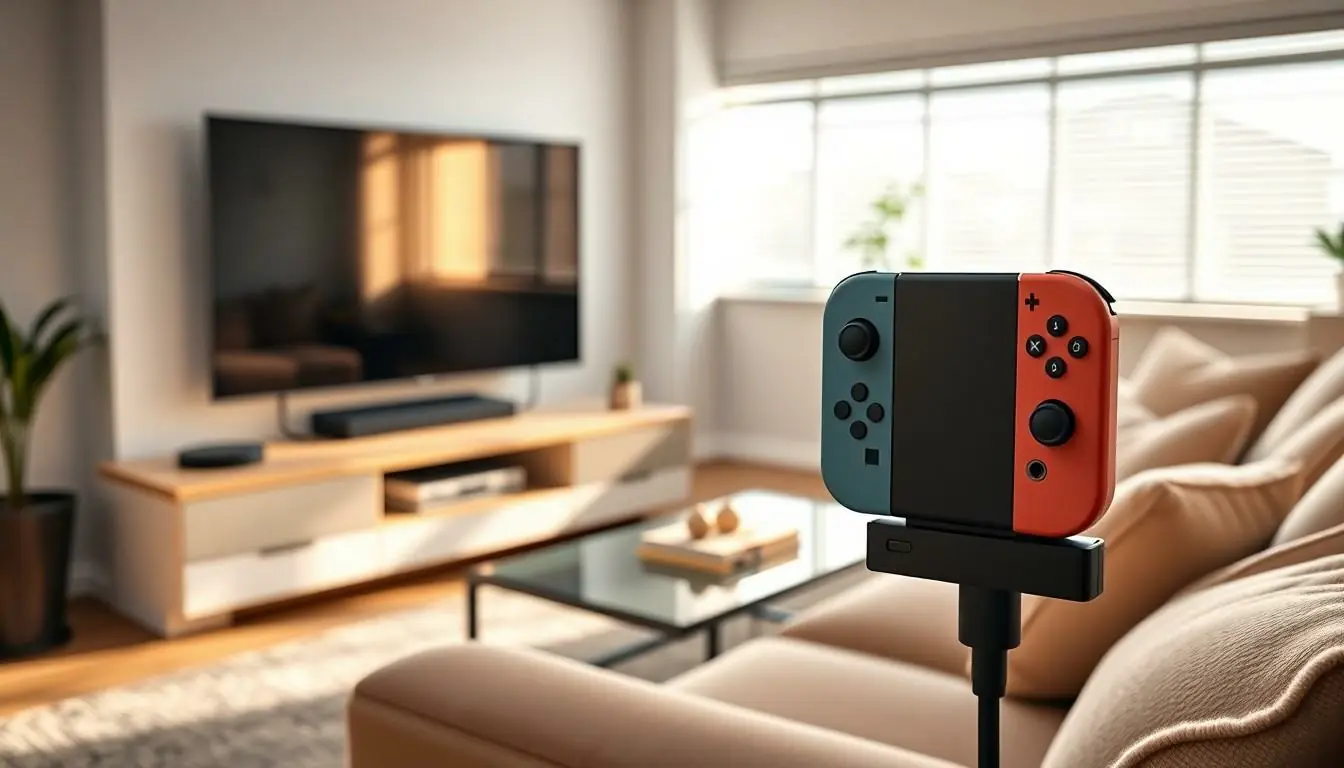Imagine this: you’ve finally snagged that shiny Nintendo Switch, and it’s time to elevate your gaming experience. But wait—how do you connect it to your TV without turning into a tech detective? Fear not! Setting up your Switch to a TV is as easy as pie, even if your tech skills are more “oops” than “oops, I did it again.”
Table of Contents
ToggleUnderstanding The Nintendo Switch
The Nintendo Switch offers versatility in gaming, allowing play on both a television and the go. Understanding its features enhances the overall gaming experience.
Overview Of The Console
Nintendo released the Switch in March 2017. This hybrid console combines handheld and traditional gaming. Players can easily switch between TV mode and handheld mode. The design includes detachable Joy-Con controllers, offering flexibility for multiplayer gaming. Many enjoy its portability, making it suitable for various settings, from home to travel.
Key Features
The Nintendo Switch boasts several standout features. An optional dock connects the console to a TV, allowing for HD gaming. The battery life ranges from approximately 4.5 to 9 hours, depending on usage. Users can access the Nintendo eShop for digital downloads, expanding their game library. The system supports local multiplayer gaming, accommodating up to eight consoles for larger group situations. Online capabilities enable multiplayer gaming across distances, enhancing interaction among players.
Preparing To Connect
Setting up a Nintendo Switch to a TV requires some initial preparation. Gather the necessary equipment to ensure a smooth connection.
Required Equipment
You’ll need the Nintendo Switch console, its dock, and the included HDMI cable. A power source is essential as well, so keep the AC adapter nearby. An HDMI-compatible TV is required for display purpose. Finally, check if your TV remote is accessible for input switching during setup. Ensure all components are in good condition to avoid connection issues.
Location Considerations
Select a suitable location for the TV and the Nintendo Switch dock. The TV should be placed within reaching distance of a power outlet. Additionally, consider the distance to the seating area for comfortable gameplay. Avoid placing the dock in direct sunlight to prevent overheating. Ensure sufficient ventilation around the dock for optimal performance. Selecting the right height and angle for the screen enhances the viewing experience significantly.
Steps For Setting Up Nintendo Switch To TV
Setting up a Nintendo Switch to a TV requires a few straightforward steps. Follow these instructions for a smooth connection.
Connecting The Dock
Begin by placing the dock in a convenient location near your TV. Locate the HDMI port on the back of the dock and connect one end of the HDMI cable to it. Next, connect the other end to an available HDMI port on your TV. Ensure the dock is connected to a power source using the included AC adapter. Lastly, confirm that the TV is turned on and switched to the HDMI input that corresponds with the port used.
Inserting The Nintendo Switch
To insert the Nintendo Switch, first ensure the console is powered off. Carefully slide the top of the device into the dock, aligning it properly so it sits securely. The screen should face outward when docked. Confirm that the console is seated correctly by checking for a snug fit in the dock. A click should sound when it connects, ensuring the device will receive power and signal.
Powering On The Console
Power on the console by pressing the power button located on the top of the Nintendo Switch. The console displays the home screen once it’s powered up. For a seamless gaming experience, ensure that the TV remains on and set to the correct HDMI input. Adjust any settings necessary, like video output resolution, to optimize performance. Enjoy playing games on the big screen immediately after setup.
Configuring Display Settings
Configuring display settings ensures an optimal gaming experience on the TV with the Nintendo Switch. Making adjustments enhances visuals and controls input options.
Accessing TV Settings
Accessing the TV settings requires pressing the “Menu” or “Settings” button on the remote. Users should navigate to the “Display” or “Picture” settings, where options for resolution, screen format, and additional display features reside. Selecting the correct HDMI input is essential to see the Nintendo Switch output. Most TVs automatically adjust the display settings when the console is powered on, but manual adjustments may improve performance. For those with advanced technology, checking for HDMI 2.0 or 2.1 compatibility can unlock enhanced features such as 4K resolution and higher refresh rates.
Adjusting Nintendo Switch Settings
Adjusting Nintendo Switch settings allows for customization to fit individual preferences. Players can access the options by selecting “System Settings” from the main menu. Under the “TV Output” section, they can modify resolution settings, choosing between 720p and 1080p, depending on available capabilities. Enabling “RGB Range” option optimizes color output for vivid graphics. Controlling the “TV Output” can also enhance sound adjustments, ensuring audio sync with the visuals. Players should save changes before exiting, allowing for a seamless gaming experience on the TV.
Troubleshooting Connection Issues
Troubleshooting connection issues with the Nintendo Switch and TV can ensure a smooth gaming experience. Several common problems may arise during setup.
Common Problems
Users frequently experience issues such as no signal displayed on the TV screen. Sometimes, the console won’t power on when docked. HDMI connections are another source of frustration, where the cable may not be properly inserted or could be damaged. Additionally, incorrect input settings on the TV can lead to confusion, resulting in a blank screen. Audio problems might also occur, with sound not transmitting through the TV speakers.
Solutions And Tips
To resolve connection issues, first check the HDMI cable for secure connections on both the dock and TV. Restarting the console and TV can refresh the connection. Selecting the correct HDMI input using the TV remote is crucial. Users should also inspect the dock and console for any physical damage. For optimal performance, it’s beneficial to use the HDMI cable provided with the Nintendo Switch, ensuring compatibility with the device. Checking for software updates on the console may also help.
Conclusion
Setting up a Nintendo Switch to a TV is an easy and rewarding process that enhances the gaming experience. With the right equipment and simple steps, anyone can enjoy their favorite games on a larger screen. Taking the time to adjust display settings and troubleshoot any issues ensures optimal performance and enjoyment.
Whether playing solo or with friends, the versatility of the Nintendo Switch allows for endless gaming possibilities. By following the guidelines outlined in the article, players can seamlessly transition from handheld mode to the big screen, making every gaming session memorable. Now it’s time to grab those Joy-Con controllers and dive into the action.





